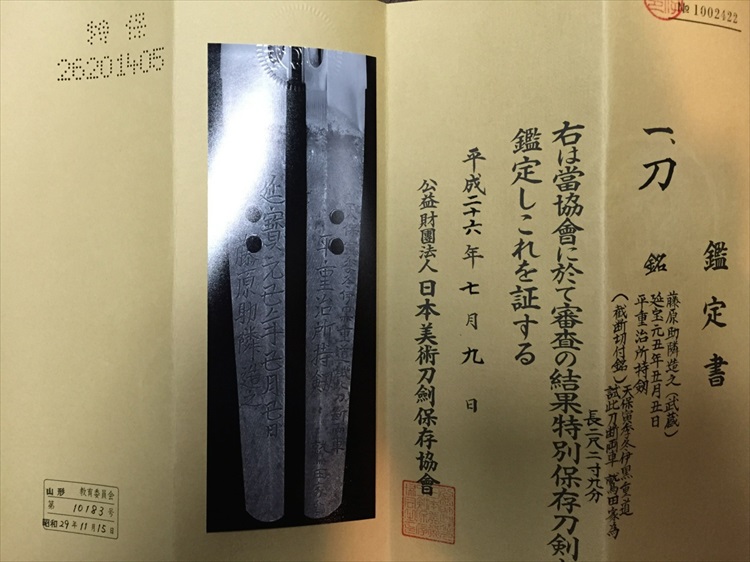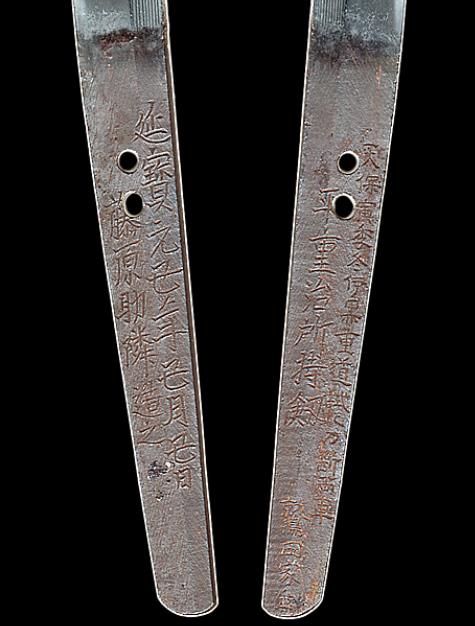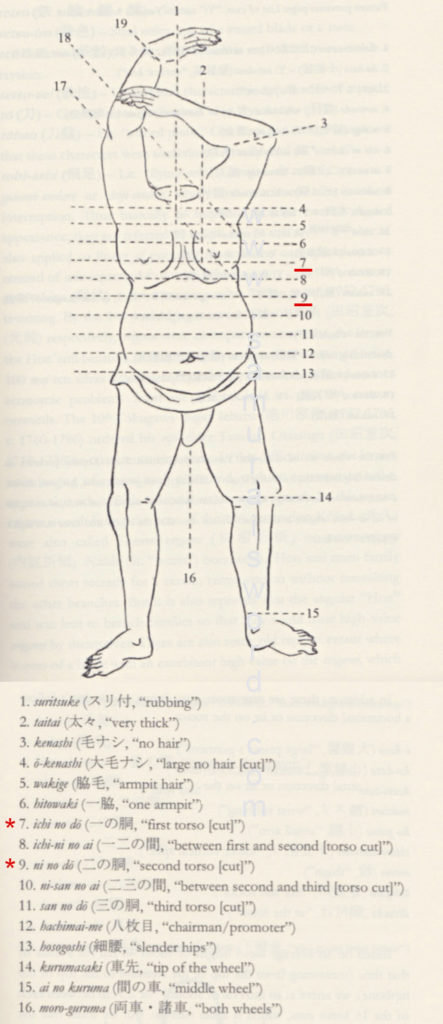Gallery Page (Display Only)
Cutting Test
This is a very nice (katana) cutting test with NBTHK Tokubetsu Hozon paper, made by Fujiwara Sukechika Enp ? -era circa 1673. T he most difficult cut test – Rio Kuruma (a cut through the hip/waist section) was performed in 1830 AD by Iguro Shigemichi . Sukechika originally came from ? saka where he was a student of Sukehiro, his civilian name was Ya´emon. There was also another smith (1684-1688) from Mino than belonged to the Zenj ? line, its possible that he was the same smith as the Enp ? -era (1673-1681). Wazamono.
The sword is inscribed with the name of its owner on nakago – “ Tiara Shigeharu “, Which was likely that of Matsudaira Shigeharu, a Daimyo (Taira) of Sanuki Han. The Washida family, retainer for the Matsudaira family (Fukui fief), requested the cutting test.
A interesting quote below about the cutting test process used by Yamada that would occur prior to his cut test from the book “Tameshigiri – The History and Development of Japanese Sword Testing” By Markus Sesko page 41. Available for purchase – click here .
Quote from Joly & Hogitaro´s 1913 publication The Sword and Samé wherein we find a description of the tameshigiri procedure: “Corpses which are used for tests are supplied by the machi-bugy? on the demand of koshimono-bugy? [weapon´s magistrate of the bakufu ]. On the day of the test two dotan are built, the examiner’s seat is one single thin mat, the ground between the examiner’s seat and tameshiba is sanded, and on it stand Yamada Asa´emon and his followers. At a fixed time, when an execution is completed, the officials return to their offices, while corpses are lying on the tameshiba with their heads. Honami the sword expert and his pupils come then, and also the consultant metsuke . The koshimono-bugy? comes later and is received by the metsuke at the entrance to the searching office. When everything is ready an announcement to that effect is made by a gaoler. All people assemble at the examiner’s seat with the koshimono-bugy? and his assistant, together with swords in boxe). The metsuke is seated on the side of the tameshiba , together with the prison watchman … Yamada Asa´emon and his assistants dressed in black kimono with a band of check or stripe at the edge of the sleeves and waist … The entrance is guarded … and the public kept out. The main gate is also guarded … The corpse is then adjusted on the dotan by two hinin directed by Yamada Asa´emon, one man hands the blade to Asa´emon, who lifts it to his forehead and fits it into the kiri-tsuka [more on that later], then he takes off the upper kataginu part of his kamishimo and his kimono , faces the dotan and places the back of the sword on the corpse, holding the tsuka in the right hand, with the left he touches the ground and salutes the examiner. Then he stands up, grasps the sword with both hands thrown back over his head (the blade almost vertically downwards), and when all his muscles are taut he cuts the corpse with an exclamation ( yah! ). Hinin take off the corpse, koshimono-bugy? and other officials approach and examine the dotan , then return to their seats. Subsequently, Asa´emon reports in writing about the condition of the blade.”
End quote…
Left Side
??????Fujiwara, Sukechika , tsukuru, Kore
?????????Dated -Enpo, 1st year, 1st month,1st day 1673
Right Side
??????????Tiara Shigeharu shoji-ken, (owned by), Washida ketame, (requested by)
????? ???? ?????Test Dated -Tenpo 1830, winter, Iguro Shigemichi, Riokuruma Tameshigiri (Shigemichi did the test)
Gallery
This Sword is not available for purchase.
If you wish to purchase a Japanese Sword please view our Nihonto for sale page or contact us directly via email or contact us at 1(608) 315-0083 any time, please include specifics of what you seek, i.e.: Katana, maker, era, price range etc.
Pictures and content may not be copied without the express permission of samuraisword.com ©











